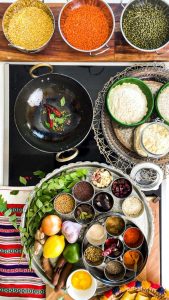
Ingredients to create a collaborative learning environment
Have you ever had a delectable Indian meal? Then you will now it means the most amazing array of colourful and flavourful spices. In the right combination, these spices transform a simple dish into a symphony of flavours. Similarly, a successful online collaborative learning environment requires a careful blend of elements to foster inclusion, develop positive attitudes, enhance meaning and engender competence.
1. The Icebreaker Spice: Respect and Connectedness
Just like a pinch of cardamom adds a touch of warmth to a dish, icebreaker activities introduce a welcoming atmosphere. Sharing names, locations (past and current), as well as course expectations are the “ground cumin” of collaboration, building a foundation of respect and connectedness. Collaborative tools like brainstorming and ground rules, much like the fragrant curry leaves, add depth and structure to the learning experience.
2. The Personal Spice: Relevance and Choice
The magic of Indian spices lies in their ability to cater to individual preferences. Similarly, fostering a positive attitude in online learning requires making the experience personally relevant. Like seeing familiar spices in a new dish, learners need to see themselves reflected in the course content. Strategies like showcasing stories of successful learners (the “witness people similar to self” spice) and incorporating “Know-What-Learned” activities (the “clove” of self-assessment) provide a sense of agency and choice, leading to a more positive experience.
3. The Intriguing Spice: Engagement and Challenge
A well-crafted Indian dish keeps you guessing with its layers of flavour. In online learning, engagement and challenge are essential for enhancing meaning. Posing problems as intriguing scenarios (the “black pepper” of intrigue) or creating simulations (the “star anise” of real-world application) add an element of surprise and keep learners hooked. Variety, the “garam masala” of the online world, is also key. Games, mini-lectures, and video presentations, used like a masal dabba, offer an array of learning experiences to cater to different preferences. Partner and small group activities, the “saffron” of collaboration, add a layer of social interaction and deeper understanding.
4. The Mastery Spice: Effectiveness and Authenticity
Finally, the true test of a good curry lies in its ability to deliver on its taste promise. Similarly, online learning should foster a sense of competence. Like the finishing touch of coriander leaves, providing feedback (both constructive and positive) is essential for growth. Demonstrating real-world applications of learned skills is like adding a dollop of ghee – it enhances the learning experience by adding a layer of authenticity and purpose.
In Conclusion
Just as a skilled chef utilises a diverse spice palette to create a culinary masterpiece, online learning facilitators can leverage a variety of strategies to create a rich and rewarding collaborative environment. By incorporating elements that build respect, promote personal relevance, stimulate engagement, and enhance competence, we can empower learners to achieve their full potential in the online world.
Sources:
Wlodkowski, R. J. 2004. Creating Motivating Learning Environments. In M. W. Galbraith (Ed.), Adult Learning Methods: A guide for Effective Instruction (3rd ed., pp. 141–164). Krieger Publishing Company.